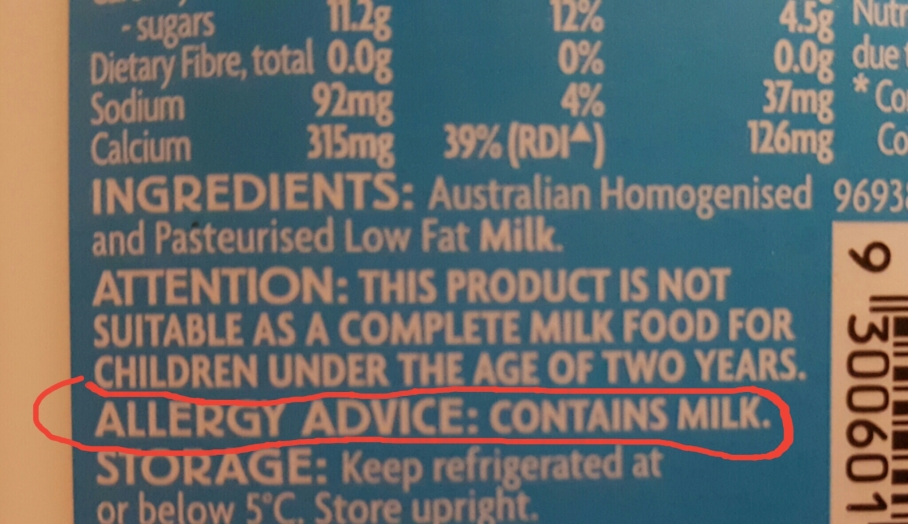Attention: Food labelling is very important. Particularly in times such as these when food allergies and sensitivities to common ingredients abound. I count myself lucky that, although I am allergic to things such as pollen, dust mites, and (of all things) horses, I have never had any food-related reactions. I did poison myself with under-cooked chicken once, but that doesn’t count. At times, however, the warnings on food labels can seem to go a bit too far – for example, the milk in my fridge doesn’t pretend to be anything other than dairy milk. Its ingredients list consists of only milk. Yet still, tucked away near the storage instructions is the official allergy advice: CONTAINS MILK. I feel like this has less to do with the intelligence of the average milk consumer, and more to do with the corporation’s healthy respect of an increasingly litigious society, but still… a tad excessive, perhaps. Even so, they didn’t go as far as the set of magic tricks my brother had as a child. The set contained a wand, a top hat, and several magic tricks, and the box was adorned with images of a little boy demonstrating how fun they all were. The fine print on three sides said ‘Instructions included’. The fourth side instead had the words, ‘Little boy not included’.
It is one of my chief delights in life when things don’t take themselves too seriously.
But there is another kind of labelling that can be hard not to take seriously. This is the kind that we apply to ourselves and others. I’m not referring here to conference name-tags, or that time I took my daughter to work and she plastered me with stick-it notes that said ‘park’ (she really wanted to go to the park, alright?). Literal labelling I can, for the most part, get on board with. It’s social labelling that I find a bit more difficult to swallow.
I have been thinking about this recently as I reflect on where I am in life, and how different it is to anything I could have expected ten years ago. I would never have imagined, for example, that any of the following terms might apply to me:
- single mother
- mentally ill
- ex-wife
- bisexual
- divorcee
- lover
Now, these are all terms that could be applied to me, but they aren’t necessarily terms I apply to myself. Not because of any negative association but because, for a range of reasons, I don’t necessarily identify with all of them. For some, it’s because of my preconceptions about what these things look like: in my mind, I still see a divorcee as a glamorous, Bacall-esque woman, drinking a martini brought by her butler, while staring out over an empty swimming pool (don’t even ask). For others, it’s because I don’t feel I’ve earned the right to wear the label: do flings, crushes and trysts ‘qualify’ me to be called bi, when I’ve never had to deal with phobic reactions? Does my anxiety ‘count’ as mental illness, when I’ve managed thus far without prescription medication? And for still others, I feel like the label does apply, but others have disagreed: someone once challenged me on whether I was a ‘single mother’, based on the fact that my daughter’s dad and I share care arrangements. That person conceptualised single mothers as those with zero support/involvement from the child’s father. Being single and a mother wasn’t enough, in his eyes, to make me a ‘single mother’.
I could go on, picking apart my by-no-means-exhaustive list. But the point is, the labels that could be applied to me by others, and the labels I apply to myself, aren’t necessarily the same. Or they might be the same, but have a subtly different meaning. And the lesson is, there is an element of arbitrary compartmentalisation that comes with social labelling, so we don’t need to take it too seriously after all. Much like walking out of an office labelled as a ‘park’.
The labels I have mentioned so far have been based on circumstance, so while there is an emotive element to them, they are relatively ‘objective’. Certain other labels we apply are grounded in value judgements, and they are far more insidious – particularly when we apply them to ourselves. These are often simple adjectives, and can start out as self-deprecating: “Oh, I’m such an idiot!”; “Ha, I’m such a clutz!”. Over time, however, these comments become part of our self-talk and can really have an impact on our self-esteem. I have noticed my daughter, at the ripe old age of seven, starting to say things like, “I’m so bad at drawing”. She isn’t, she’s just comparing herself to the adults around her who have had twenty-five more years than her to work on their fine motor skills. I will be so sad if she convinces herself that she’s ‘bad’ at drawing, when it’s something she loves to do.
These labels, like those on certain jam jars, can be very hard to remove once applied. And even ‘positive’ labels can cause a sticky mess. I carry a massive fear of failure from being told as a kid I would achieve great things, and I could be whatever I wanted. Somehow, my younger self turned these encouragements into a crippling terror of letting everybody down, to the point where it was easier for me not to try anything new or challenging. Because if you don’t try, you can’t fail. This is something I have overcome substantially in the last couple of years, but it still feeds my epic procrastination skills.
Social labelling is a useful tool. It helps us circumscribe our identities and allows us to identify with and against others. But, like any other tool, it should be used thoughtfully. We should strive to use social labelling, of ourselves and of others, like food labelling: with the aim to prevent harm, not to inflict it.
